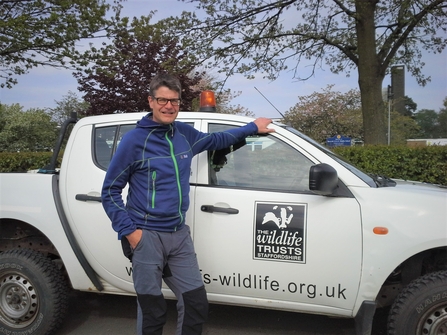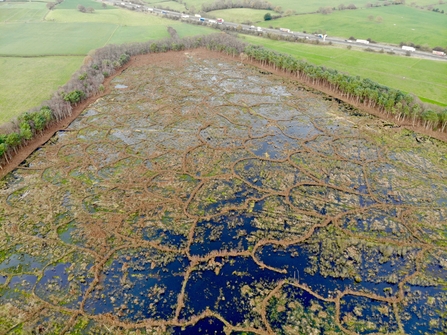
What we want from COP26

In Britain, although not as acute as in other parts of the world, the impacts of climate change are already starting to be felt. Last year, there was increased flooding in Staffordshire. The nearby county town of Stafford was badly hit earlier this year and in recent months several roads across Stoke-on-Trent have been made impassable following heavy rainfall. In 2020, 281 properties suffered from internal flooding in the county, with an estimated damage and recovery cost of over £8 million1.
At the other end of the scale, we have seen an increase in moorland and heathland wildfires during the hotter, drier summers we’re experiencing. The 2018 wildfire at the Trust’s Roaches nature reserve near Leek was particularly devastating – destroying 200 acres of wildlife habitat (below).
Our wild species are battling multiple threats: habitat loss and fragmentation, pollution, invasive species and disease. A study in 2019, the State of Nature report, revealed 41 per cent of UK wild species are in decline, with 15 per cent in danger of disappearing altogether. Climate change is adding more pressure, driving down populations even further.
Ground-nesting birds are seeing their young being washed away in floodwaters; waders are struggling to find food in parched wetlands; hedgehogs are waking early from hibernation but are unable to replenish their energy supplies.
Nature is a key theme being discussed by leaders at COP26, and organisers have acknowledged that ‘there is no pathway to net zero without protecting and restoring nature’. The Prime Minister has introduced some tentative policies to reflect this – such as mass tree-planting – and they are welcome but not nearly enough.
What we must realise is that by fixing nature – by protecting, expanding and improving our wild places – we can start to solve the climate crisis too. The climate and ecological emergencies are inextricably linked – and we can’t resolve one without the other. Why? Because ecosystems are an intrinsic part of the carbon cycling process. Healthy, functioning wild places on land and sea absorb and store vast amounts of CO2. If we were to restore all our natural habitats across the UK, we could provide 37 per cent of the CO2 mitigation needed by 2030 to meet the Paris Agreement.2 Along with reducing our emissions and developing new carbon-removing technologies, nature is a vital weapon in our armoury.
We’re all aware that planting trees sucks carbon out of the air – but how many people know that other natural habitats have these abilities too, like peatlands, wetlands and grasslands? Peatlands are in fact a far more efficient carbon sponge than forests, and are currently locking up a massive 3.2 billion tonnes of carbon in the UK3. And if we looked after them better, they could do a lot more than this. The majority of UK peatlands are damaged and are emitting CO2. If we restored them we could store a further 23 million tonnes CO2e per year. That’s roughly equivalent to removing more than double the carbon footprint of all the residents in Staffordshire!

You may think of peatlands as a habitat of the Scottish uplands, but we actually have our own peatland network across Staffordshire; many in Newcastle-under-Lyme. With generous donations from supporters, we recently purchased Craddock’s Moss, a 47-acre lowland raised bog (pictured above, photo by Ben Whiles). This peatland is storing 11,000 tonnes of carbon within its soils and vegetation – equivalent to the carbon footprint of half the population of nearby Whitmore. As we continue to restore it, it will actively absorb more greenhouse gases and lock them away for a very long time. But some of our local peatlands are still unprotected, and are vulnerable to development.
The problem is, we’ve taken our natural assets for granted for far too long. Despite being fundamental to the economy, we don’t value ‘natural capital’ in the way we value human or produced capital. Only 3 per cent of global climate finance is spent on nature-based solutions to the crisis5.
At COP26, I’d like to see global leaders clearly recognising the value of nature to our society, making a genuine commitment to its recovery and pledging more investment into it.
We also need our leaders to do this on a local level. I’d like the councils in Stoke-on-Trent and Newcastle to work with Staffordshire Wildlife Trust to create a Nature Recovery Network across our area – a place where nature thrives alongside people. If you agree, make sure your local leaders know!
Sources:
1: Climate Change Annual Report 2020/21, Staffordshire County Council
2: Natural climate solutions, Griscom et al., Proceedings of the National Academy of Sciences of the USA, 2017,
3: Implementation of an Emissions Inventory for UK Peatlands, Centre for Ecology & Hydrology, 2014
4: Implementation of an Emissions Inventory for UK Peatlands, Centre for Ecology & Hydrology, 2014
5: https://ukcop26.org/nature/ https://publications.wri.org/nature-based-solutions-adaptation

